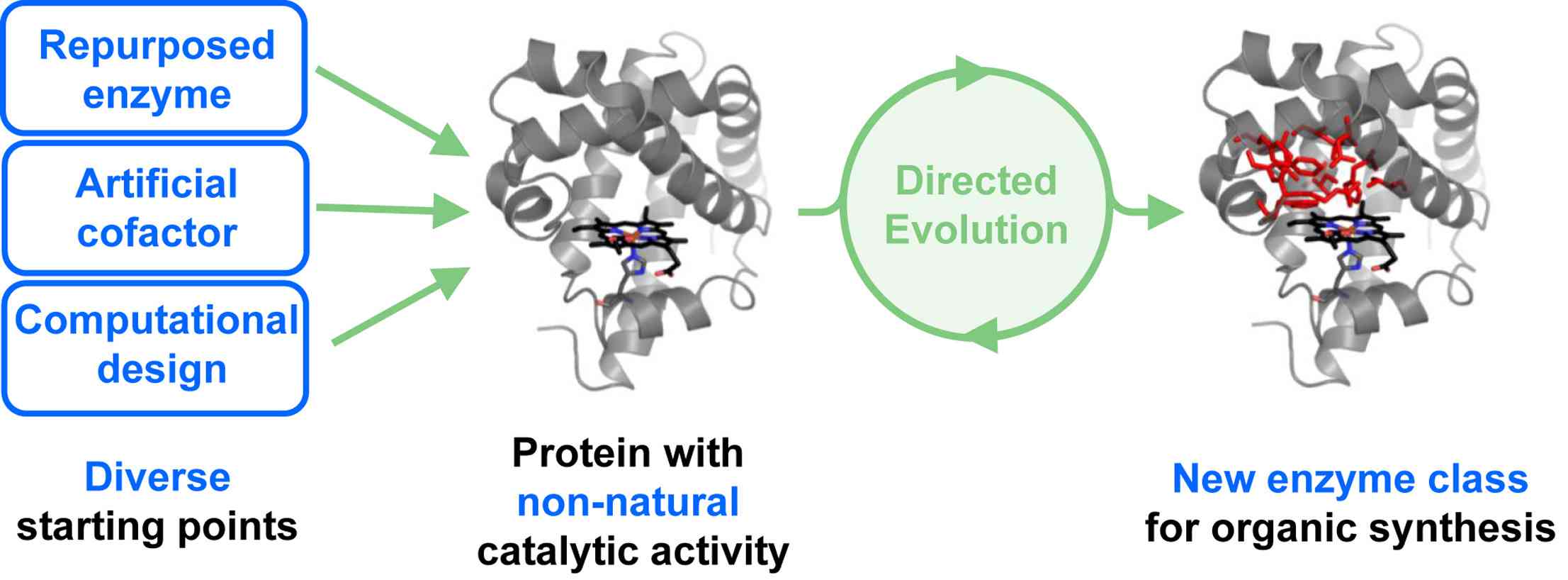The Computational Design of Non-Natural Enzyme Functions is a cutting-edge field of study which involves the use of advanced computational tools to design non-natural enzymes. These enzymes are not found in nature and are capable of catalyzing reactions that would not ordinarily occur in natural biochemical pathways. The designing process involves a thorough analysis of the desired function, followed by the use of computational models to conceptualize and then realize these enzymatic structures. By designing enzymes capable of initiating non-natural reactions, we can potentially develop innovative and ground-breaking solutions across a plethora of sectors.
 Design and evolution of enzymes for non-natural chemistry (Stephan C. H., 2017)
Design and evolution of enzymes for non-natural chemistry (Stephan C. H., 2017)
Service Process
Our service process is designed with utmost care and is broken down into several stages to ensure optimal results:
- Engagement Phase: We initiate by having an in-depth interaction with you to gain insight into your specific needs and objectives. This engagement is crucial for us to understand your expectations and to tailor our services accordingly.
- Design Phase: Based on the understanding gained from our initial engagement, we employ advanced computational tools to design potential enzyme functions. Our team of experts utilizes their technical knowledge and expertise during this phase to create innovative and efficient designs.
- Preliminary Testing Phase: After the design phase, we carry out initial testing of the potential enzyme functions. This involves evaluating the designs to see if they meet the required criteria and can successfully facilitate the desired reactions.
- Refinement Phase: If we identify a promising design from the preliminary testing phase, we proceed with a more detailed analysis. Here, we refine the design, making necessary modifications and improvements to optimize its performance.
- Rigorous Testing Phase: Following the refinement, the modified design undergoes rigorous testing. This stage is crucial to ensure that the design is not only efficient but also reliable and capable of meeting the desired objectives.
- Finalization Phase: After successful testing and refinement, we finalize the design. This finalized design is then ready to be put into practical use, potentially catalyzing reactions not naturally occurring and paving the way for innovative solutions in various sectors.
By following these stages, we strive to provide a thorough and high-quality service that meets and exceeds our clients' expectations. If you have any questions, need more information, or would like to discuss a potential project, please don't hesitate to contact us. Our team is always eager to help and share our expertise.
Applications
| Application |
Description |
| Biocatalysis |
Computational design of non-natural enzyme functions revolutionizes biocatalysis by enabling enzymes to catalyze reactions beyond their natural repertoire. By redesigning enzyme active sites or scaffolds, novel enzymatic activities can be engineered for the synthesis of valuable compounds, including pharmaceuticals, fine chemicals, and biofuels. This approach offers advantages such as high selectivity, mild reaction conditions, and reduced environmental impact, making it a promising strategy for sustainable bioproduction processes. |
| Synthetic Biology |
Computational design of non-natural enzyme functions plays a vital role in synthetic biology for constructing bespoke metabolic pathways and biosynthetic routes. Engineered enzymes with tailored functions facilitate the biosynthesis of complex molecules, ranging from commodity chemicals to advanced materials and therapeutics. By combining rational design strategies with high-throughput screening techniques, synthetic biologists can create custom enzymes that optimize pathway efficiency, substrate specificity, and product yield, accelerating the development of bio-based manufacturing platforms for various industrial applications. |
| Drug Discovery |
Computational design of non-natural enzyme functions contributes to drug discovery efforts by providing tools for the development of novel therapeutic agents. Engineered enzymes can be designed to target specific disease-related pathways or metabolites, offering opportunities for enzyme-based therapies or drug delivery systems. By simulating enzyme-substrate interactions and applying molecular modeling techniques, researchers can identify and optimize enzyme variants with enhanced activity, stability, or substrate specificity, potentially leading to the discovery of new drugs with improved efficacy and reduced side effects. |
| Environmental Remediation |
Computational design of non-natural enzyme functions holds promise for environmental remediation applications, particularly in the detoxification of pollutants and waste streams. Engineered enzymes can be tailored to degrade harmful contaminants, such as pesticides, industrial chemicals, or emerging pollutants, into non-toxic or less hazardous compounds. This approach offers a sustainable and eco-friendly solution for mitigating environmental pollution, contributing to the preservation of ecosystems and human health. By optimizing enzyme properties through computational modeling and protein engineering techniques, researchers can design enzymes with enhanced catalytic efficiency and substrate specificity for targeted pollutant degradation. |
| Renewable Energy Production |
Computational design of non-natural enzyme functions is relevant to renewable energy production, particularly in the development of enzymatic systems for biofuel synthesis and biomass conversion. Engineered enzymes can be designed to efficiently convert lignocellulosic biomass into biofuels, such as ethanol or butanol, through enzymatic hydrolysis and fermentation processes. By optimizing enzyme activity, stability, and substrate specificity, researchers aim to enhance the efficiency and viability of bioenergy technologies, contributing to the transition towards sustainable and carbon-neutral energy sources. |
FAQs
We realize that you may have numerous inquiries concerning this service. To help you understand better, we have compiled a comprehensive list of responses to some of the most frequently asked questions. If you have more specific or detailed questions, don't hesitate to get in touch with us directly.
Q: Can you elaborate on what exactly the Computational Design of Non-Natural Enzyme Functions entails?
A: Most certainly. The Computational Design of Non-Natural Enzyme Functions is a distinct process that harnesses cutting-edge computational tools to design enzymes. These enzymes have the unique capability to execute reactions that do not take place naturally in nature.
Q: Can you explain why this study is necessary and what its implications are?
A: Absolutely. This study holds immense importance as it enables the creation of novel biochemical reactions. This opens up a world of possibilities, potentially paving the way for groundbreaking solutions across a myriad of fields.
Q: Could you provide a detailed explanation of how this process works?
A: Our team of experts makes use of sophisticated computational tools to design innovative enzyme structures. Post design, these structures are subjected to extensive testing to evaluate their ability to catalyze non-natural reactions.
Q: Could you list the industries that can benefit from this service?
A: This service has the potential to be beneficial across a wide spectrum of industries. This includes but is not limited to pharmaceuticals, environmental science, and industrial manufacturing, among others.
Q: What are the associated risks, if any?
A: Like any scientific process, there are inherent risks involved. However, we employ thorough precautions and stringent measures to reduce these risks as much as possible.
Q: What is the duration of the process? Is it fixed, or does it vary?
A: The timeframe for the process can vary, primarily depending on the complexity of the desired enzyme function. It is not fixed and can change based on the intricacy of the project.
Q: How successful are you at designing a functional enzyme? Do you have a success rate?
A: While the success rate can indeed fluctuate, our seasoned team of professionals is committed and dedicated to delivering the most optimal results possible.
Q: Can any type of enzyme function be custom-designed?
A: While there may be certain limitations, our proficient team has demonstrated exceptional skill at designing a diverse array of enzyme functions.
Q: How can I avail of your services? What is the procedure for the same?
A: Initiating the process to avail our services is quite straightforward. You can easily reach out to us via our official website or contact us by phone to discuss your specific requirements.

































 Design and evolution of enzymes for non-natural chemistry (Stephan C. H., 2017)
Design and evolution of enzymes for non-natural chemistry (Stephan C. H., 2017)